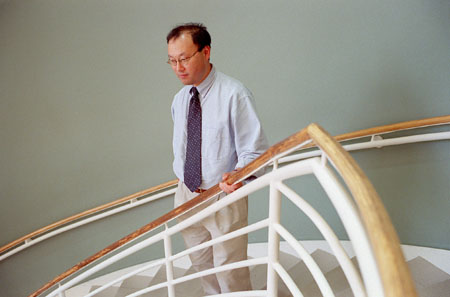Bacteria stripped of antibiotic resistance
Gene therapies being developed to fight growing problem of hospital infections

Infectious bacteria that have developed resistance to even the most potent antibiotics are making hospital stays increasingly hazardous. Take the drug vancomycin, for example, which used to be a last line of defense against virulent strains of enterococci and staphylococci that can be life-threatening. These bacteria continually develop new ways to beat vancomycin.
A way to break this vicious cycle has been found by researchers at Harvard Medical School and Beth Israel Deaconess Medical Center in Boston. They put a new gene into a bacterium called Enterococcus faecalis, which has recently emerged as a major source of infection in hospitals in the United States and other developed countries. This strategy reversed the bug’s resistance to vancomycin.
“Tiny one-celled bacteria show incredible resistance to the best efforts of people in universities and industry,” says Roger Inouye, a Harvard Medical School instructor who is part of the research team. “Instead of trying to stay ahead of them, we are exploring ways to give new potency to established antibiotics.” The research is supported by the National Institute of Allergy and Infectious Diseases.
“We have been successful with a dangerous enterococci strain, and we are considering applying the same strategy to staph bacteria,” Inouye added. The two groups cause pneumonia, inflammation of the heart lining, meningitis, toxic shock syndrome, and other diseases.
Besides colonizing patients and surfaces in hospital rooms, these bacteria are a growing problem in facilities that breed and process food animals. “Multi-drug resistant bacteria are a big problem in the animal husbandry industry in the United States and Europe,” Inouye notes. “And it’s a problem that’s getting worse.”
Getting to patients
To rid Enterococcus faecalis of its defenses, Inouye and his colleagues used electroshocks to force subversive genes into cells growing in a laboratory dish. Obviously, that’s not a practical way to get genes into an infected person. Therefore, the researchers are searching for ways to package the resistance-reversing genes so they can be given in the form of a pill or an injection.
One way is to encase them in particles of fat. Such fats pass easily through the cell walls of bacteria into which the genes are transferred. Once inside, they will block the activity of other genes that give rise to antibiotic resistance.
An obvious problem with this route of attack involves possible penetration into a patient’s healthy cells.
Another strategy is to incorporate the genes into viruses that infect bacteria, so-called bacteriophages. Such viruses punch holes in the cell walls of bacteria and release their contents which, in this case, would be genes custom-tailored to break down drug resistance.
Doctors used these viruses to destroy bacteria before science developed antibiotics such as penicillin. But this type of warfare produced toxic side-effects. “Today, it’s possible to make purer preparations of these engineered viruses, reducing or eliminating the side-effects,” Inouye explains. If this strategy works, the invading viruses could be tailor-made for each strain of enterococci, staph, and other bacteria.
The Harvard researchers are collaborating with Exponential Biotherapies Inc. of Port Washington, N.Y., to develop people-friendly ways to deliver bacteriophages. “We already have the phages we want to inject into infected patients, and we’re working on ways to get anti-resistance genes into those viruses,” explains Richard Carlton, president of the company. “Some bacteria can kill phages by chopping up their DNA. But our virus preparation carries a gene that blocks that capability. It’s a Trojan horse approach.”
One-two punch
Inouye began using customized genes to foil bacteria by coincidence. He was working on ways to use the technique with the HIV virus that causes AIDS. In a lab next door, Robert Moellering Jr., a Harvard professor of medicine, puzzled over the problem of bacterial resistance. “We got into a conversation and decided to try using gene therapy on resistant bacteria,” Inouye recalls.
The researchers cloned what is known as an anti-sense gene, one that blocks the activity of another gene. In this case, the anti-sense gene keeps the gene responsible for resistance from turning on. They paired the anti-sense gene with a promoter, the same substance that boosts the resistance-causing gene. But in this case, the promoter hypes anti-resistance.
“It works like a one-two punch,” says Inouye. “The promoter reduces some of the resistance, then the anti-sense gene does the rest.”
Even if this technique is successfully deployed in humans, the Harvard team doesn’t believe it will win the war. Bacteria such as enterococci are capable of swapping genes with their close relatives. One cousin might give another a new gene that renews resistance. Just as likely, of course, a bacterium might pass along the anti-resistance gene.
“Frankly,” admits Inouye, “I wouldn’t be surprised if Enterococcus faecalis or other enterococcal strains find a means of getting around our gene therapies.”
Richard Carlton believes that their Trojan horse preparation will be stable enough to avoid such infiltration. If not, says Inouye, “We’re looking at ways that we can detect when bacteria do this.”
The smartest creatures on Earth always have to stay one step ahead of some of the most primitive ones.




